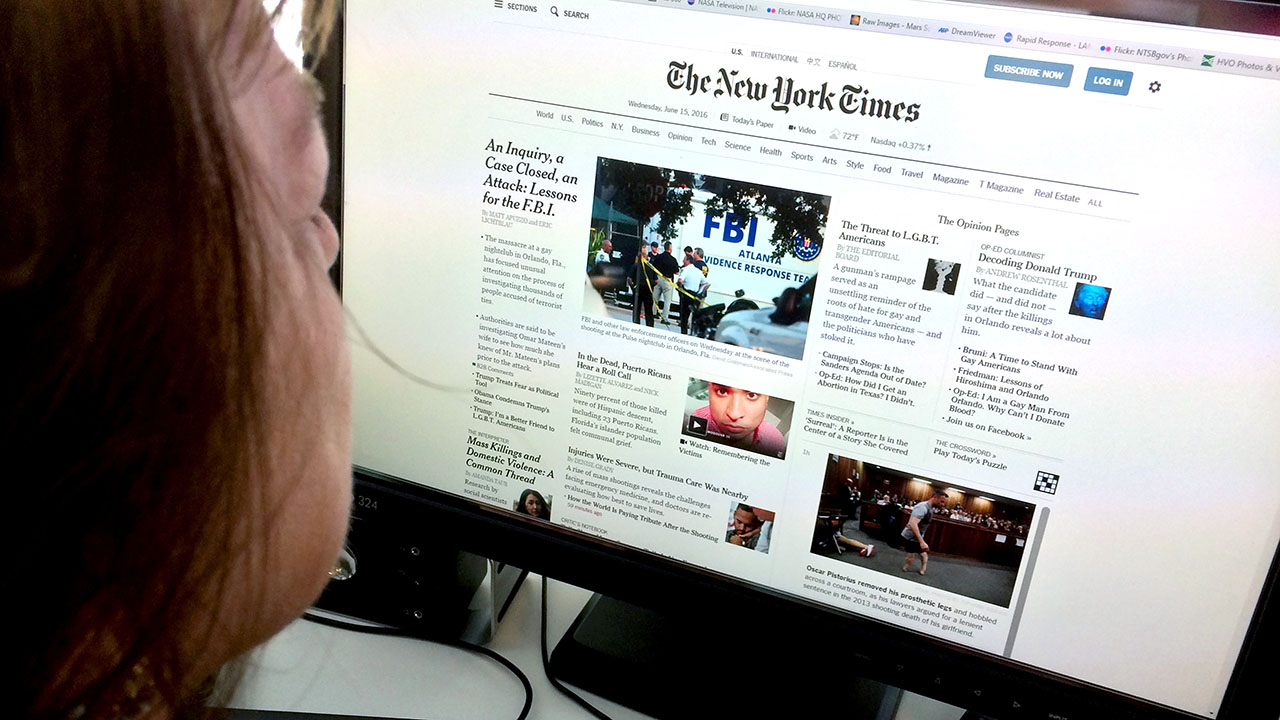The Influence of Social Media on the Way We Take In News Online
Social network has fundamentally changed news intake. It gives prompt accessibility to information, frequently eclipsing traditional media outlets. This quick circulation comes with obstacles. Individuals face the risk of encountering misinformation and ending up being trapped in resemble chambers. The formulas driving customized content can obscure varied viewpoints. As these characteristics progress, recognizing their effects ends up being necessary for notified engagement in public discussion. What approaches might assist browse this complex landscape?
The Development of News Intake in the Digital Age
As technology progressed, the means individuals eaten news changed considerably in the electronic age (stnews.live). Standard newspapers and relayed media began to decrease as the web became a key source of information. On-line platforms offered instantaneous accessibility to newspaper article, video clips, and podcasts, enabling users to stay informed at any kind of time. The comfort of smart phones even more accelerated this change, making it possible for customers to receive updates on the move
Additionally, the increase of news collectors and sites facilitated the usage of varied perspectives, encouraging individuals to tailor their news intake based on personal passions. This evolution likewise prompted news companies to adjust their techniques, concentrating on electronic content and engaging visitors through multimedia layouts. Consequently, the traditional barriers of time and space in news shipment lessened, resulting in a much more prompt and tailored news experience for target markets worldwide.
The Role of Social Media Operatings Systems in News Distribution
Social media platforms have transformed news circulation by giving instantaneous access to information. Their algorithm-driven material curation usually prioritizes engagement over accuracy, resulting in considerable credibility obstacles (stnews.live). As individuals navigate this landscape, the effects for news usage and public discussion become progressively intricate
Instantaneous News Accessibility
Typical news outlets have actually long been the primary source of details, the rise of social media platforms has dramatically transformed just how news is accessed and consumed. Instantaneous news accessibility has actually ended up being a characteristic of the digital age, enabling users to get updates in actual time. Systems such as Twitter, Facebook, and Instagram enable news to spread rapidly, frequently surpassing traditional media in speed and reach. Users can share tales, comment on events, and involve with journalists, producing a dynamic communication in between the audience and news material. This immediacy fosters a culture of urgency, motivating users to look for information rapidly. Consequently, the assumption for timely news has actually improved journalistic techniques, engaging wire service to adapt their methods to fulfill the needs of a busy electronic setting.
Algorithm-Driven Content
While customers proactively involve with web content on social media, the algorithms that govern these platforms play an essential duty in establishing which news stories gain visibility. These formulas analyze individual behavior, preferences, and interaction metrics to curate personalized news feeds. Because of this, particular tales might be intensified while others remain unknown, usually focusing on mind-blowing or trending topics over substantive reporting. This careful direct exposure shapes individuals' understandings of current events and influences public discussion. In addition, the dependence on algorithm-driven content can create echo chambers, where individuals are mostly revealed to viewpoints that align with their own beliefs. The dynamics of news distribution on social media systems substantially affect just how individuals consume and analyze details in the electronic age.
Reliability Difficulties
As users increasingly turn to social media for news, the trustworthiness of details experienced on these platforms becomes a pushing worry. The decentralized nature of social media permits any individual to publish material, frequently obscuring the lines between reputable journalism and false information. Formulas focus on engagement over precision, resulting in the widespread dissemination of sensational or misleading tales. This atmosphere postures considerable difficulties for users attempting to recognize trustworthy sources. Social media systems, while seeking to deal with false information with fact-checking and web content small amounts, run the gauntlet for incongruities and prejudices in their approaches. Eventually, the responsibility exists with individuals to seriously evaluate the news they eat, as the fast spread of information commonly outmatches confirmation initiatives by platforms.
The Surge of Person Journalism and User-Generated Content
The increase of resident journalism has actually empowered everyday individuals to share news and viewpoints, typically giving insights that typical media may overlook. However, this change also presents significant obstacles, specifically the spread of misinformation that can arise from unverified content. As user-generated material becomes extra common, the balance in between genuine voices and precision in reporting continues to be a critical concern.
Empowering Day-to-day Voices

Difficulties of False information
While the rise of citizen journalism has actually opened up methods for varied voices in the media landscape, it has actually also introduced significant difficulties connected to misinformation. The simplicity of sharing details through social networks systems permits individuals to disseminate news swiftly, yet this rapid spread often comes at the expense of accuracy. User-generated material often lacks the rigorous fact-checking and editorial oversight that conventional journalism gives. Sensationalized or false narratives can obtain grip, misleading audiences and forming public assumption. The mixing of viewpoint and fact within social media makes complex the distinction between legitimate info and misinformation. Therefore, customers need to navigate why not find out more an increasingly complex media setting, needing vital thinking abilities to recognize trusted news resources in the middle of the noise

Misinformation and Its Implications for Public Discussion
As social media systems progressively control the landscape of details dissemination, the spreading of misinformation positions significant obstacles for public discussion. Misinformation, commonly made to misguide or provoke emotional feedbacks, can misshape assumptions of fact and undermine count on in legitimate resources. This sensation causes polarized perspectives, as people move in the direction of resemble chambers that enhance their beliefs, better lodging departments within society.
The ramifications for public discussion are extensive. When people depend on incorrect information, meaningful dialogue reduces, and the democratic process experiences. Misinformation can incite anxiety and complication, impacting public health, safety, and political security. Therefore, cultivating media proficiency becomes important, equipping individuals to critically examine info and determine reality from fiction. Dealing with the challenges positioned by misinformation is important for maintaining the integrity of public discussion and guaranteeing a knowledgeable population with the ability of taking part in useful conversations.
The Impact of Formulas on News Visibility
Offered the main function of algorithms in determining material visibility, their influence on news intake is profound. These algorithms, used by social media platforms, prioritize particular types of material based on individual engagement and choices. As a result, newspaper article that line up with popular patterns or audience rate of interests are most likely to be displayed prominently, while less astonishing tales may be neglected. This develops an atmosphere where users are subjected primarily to info that reinforces their viewpoints, possibly causing resemble chambers.
Additionally, the consistent evolution of algorithms implies that news companies have to adapt their approaches to line up with these changing specifications, typically focusing on clickbait or psychologically charged headings. Consequently, the honesty of news reporting can be endangered, as critical tales might not receive the presence they are worthy of. The description algorithmic shaping of news exposure as a result plays a vital role in influencing public understanding and understanding of present events.
The Change Toward Visual Storytelling in News Media
Increasingly, news media is embracing aesthetic storytelling as an effective device to engage audiences. This approach leverages images, video clips, infographics, and interactive aspects to share information much more efficiently than standard text-based formats. As interest extends reduce, visuals use a fast, impactful way to interact complicated stories and grab customers' passion.
Systems like Instagram and TikTok have further accelerated this trend, engaging news organizations to adjust their material approaches to fit these visually-driven environments. By integrating engaging visuals, news outlets can enhance emotional links and foster greater understanding of topical problems.
Aesthetic narration enables for even more diverse stories, showcasing several perspectives with vibrant discussions. As audiences progressively eat news via smart phones, the shift toward visuals not only satisfies user preferences yet also assists to damage down barriers to information gain access to. Ultimately, this evolution reflects a wider makeover in just how news is created and eaten in the electronic age.
Future Fads: Navigating the Changing Landscape of News Usage
While the electronic landscape proceeds to develop, news consumption is poised for significant makeover driven by emerging technologies and altering target market behaviors. As synthetic knowledge and artificial intelligence development, individualized news feeds will certainly come to be a lot more common, allowing customers to get material tailored to their rate of interests. This customization could lead to better involvement yet also raise worries regarding echo chambers and false information.
Additionally, the rise of voice-activated devices and wise audio speakers will certainly influence exactly how news is provided, moving the focus from visual to auditory layouts. This trend might encourage wire service to take on even more succinct and interesting audio content.

Frequently Asked Inquiries
Exactly How Do Social Media Communications Affect News Reputation?
Social media stnews.live site communications can substantially affect assumptions of news reputation. Interaction metrics, such as likes and shares, often form audience trust fund, with preferred articles acquiring regarded legitimacy, despite the precision or reliability of the details offered.
What Role Do Influencers Play in Shaping News Narratives?
Influencers considerably shape news stories by leveraging their platforms to amplify specific stories, usually tailoring web content to their audience. This can lead to biased point of views, affecting public understanding and prioritizing sensationalism over accurate reporting.
Exactly How Can Users Identify Reliable News Resources on Social Media?
Customers can recognize dependable news sources on social media by checking the resource's credibility, confirming facts with several electrical outlets, assessing the professionalism and trust of the content, and identifying potential predispositions in reporting to assure accurate info.
What Influence Does Social Media Carry Conventional Journalism Jobs?
Social network significantly affects typical journalism work by modifying income versions, decreasing demand for print media, and promoting competitors from person journalists. As a result, lots of specialists face task instability and have to adapt to rapidly changing media landscapes.
Just How Do Various Demographics Consume News on Social Media?
Different demographics show diverse choices for news intake on social media sites. More youthful target markets prefer systems like TikTok and Instagram for fast updates, while older people tend to prefer Facebook and Twitter for much more thorough conversations and posts.